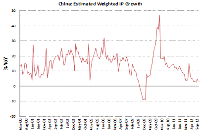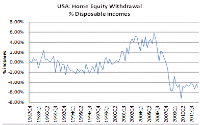Tyndall Monthly Commentary: The expectations gap
Financial markets are optimistic about an improvement in the global economy this year but policymakers continue to hold a bleaker view.
Monday, January 7th 2013, 11:35AM
by Andrew Hunt

As is now traditional at this time of year, financial markets are looking forward to some form of global economic recovery unfolding over the next 12 months. Last year, the hypothesised driver for the widely prophesised recovery was expected to be an end to the Euro Crisis – which plainly did not happen – but this year’s catalysts are expected to be a Chinese economic renaissance and the “knock on” effects of the recent revival in the US housing market. Once again, though, global policymakers are much less certain of this benign scenario coming to pass. At the beginning of 2012, we encountered perhaps the widest gap that we had ever uncovered between expectations within financial markets and expectations amongst central bankers and, rather worryingly, this expectations gap does not seem to have closed much with regard to the year ahead. Indeed, many central bankers – including the US’s Mr Bernanke – are still attempting to find new ways to ease their policy regimes and we can only assume that this is because they continue to fear for the global economic outlook.
With regard to possible positive drivers for 2013, it is certainly true that the Chinese central government has launched some form of stimulus package for their economy over recent months. The government’s fiscal deficit has expanded by perhaps the equivalent of 2% of national GDP (a significant but not exceptional amount) and domestic credit growth has picked up. Over the last 3-4 months the Chinese authorities may have added perhaps as much as US$1 trillion of new credit to their $6 trillion economy, a much more significant action.
Unfortunately, it is not clear just how much of this new credit has simply disappeared into the black hole that is the local government financing crisis or into the capitalisation of interest amongst China’s now highly indebted and cash flow constrained mid-sized company sector, but it is nevertheless clear that at least some of the $1 trillion of new credit has found its way into the property markets, albeit through some occasionally rather convoluted channels. The arrival of this new wave of credit has already led to a marked revival in house prices and even a pickup in construction activity but what is also clear from China’s economic data is that the manufacturing sector in general, and exporters in particular, have not been able to benefit from this event.
Despite strong rises in the production of cement and other construction-related materials, overall production growth remains very weak. It therefore seems that China’s easing and recovery is confined to a small part of the economy and while this may provide some impetus to the financial markets’ China theme in the near term, in the longer term the world may find itself ultimately underwhelmed by the Chinese “recovery”.

In the USA, meanwhile, it is apparent that the domestic housing market is somewhat stronger than it was a year ago, although worries over the “fiscal cliff” and the possible reduction in mortgage interest tax relief have led to some cooling in the market of late. The recovery in the market, though, is being led primarily by foreign buyers and domestic households are still attempting to rebuild their home equity stakes by repaying mortgages and holding their level of net investment within the market at a modest level. This is a very different situation to that that persisted in the mid-2000s, a period during which US households were removing large quantities of equity and cash from their homes via strong mortgage borrowing so that they could fund high absolute levels of consumption. Rather than taking money “out of the housing market ATM”, households still seem to be making deposits and this is one reason that the retail sales data does not seem to be quite as strong as many have been expecting.
Moreover, it is also apparent that US households – like those in the UK, Germany and elsewhere – are constrained by weak disposable income trends. Despite the useful improvement in the labour market this year, rising taxes, falling benefits and rising subsistence costs have all taken their toll on household incomes and even the type of modest fiscal tightening that we are expecting in 2013 can only make these weak income trends even more challenging.

Consequently, we not only expect US consumer spending to disappoint over the year, we also expect a further increase in what are already becoming quite elevated default rates within the consumer credit industry. In the UK, the continued fiscal austerity regime will likely lead to a similar weak outcome for the economy in 2013.
On the European mainland, we expect to see a continued contraction in the already embattled countries of the periphery, which may now be considered to have entered a depression. The weakness in the periphery, though, is now migrating into the core via the regional trade links and although Germany may just avoid a technical recession in 2013, we suspect that France will succumb and that this will have severe and adverse consequences for the country’s fiscal accounts.
Also with regard to Europe, we also wonder if the recent changes within the composition of the ECB’s balance sheet towards a situation in which virtually all of its assets are now accounted for by loans to the periphery, while its liabilities are overwhelmingly concentrated in the core countries, will lead to further tensions in the region’s political unity. Moreover, with the day to day management of the Euro system now beginning to look more and more like that of the Ruble Bloc in the early 1990s, we wonder if the forex markets may soon start to place downward pressure on the currency.
Certainly, it is our sense that the ECB has morphed under Draghi’s influence away from a true single currency and more towards a currency bloc in which the growth rate of the supply of money is now primarily determined by the needs of the weakest members rather than the wishes of the strongest members and we would expect this shift to ultimately be reflected in the forex markets. Usefully, a weaker currency might then relieve some of the pressure on the periphery but, by raising import and hence headline inflation rates in the core, it may not be an overly popular event with German voters in this important year. At the very least, we expect the Euro’s political and economic crises to rumble on over the course of 2013 and therefore the Euro could continue to be a source of volatility for financial markets as the year continues.
Finally, we would note that underlying economic conditions in Japan are perhaps somewhat better than many realise. The combination of the central bank’s “tough love” regime and the damage that emanated from the earthquake seems to have forced Japanese companies to become more flexible and even a little more profitable, with the result that we suspect that the economy has finally begun to lay the foundations of a sustainable recovery. Unfortunately, this potentially positive outlook may yet be compromised by the new Prime Minister Mr Abe, who seems determined to interfere in economic policymaking and his desire to oblige the Bank of Japan to launch yet another Quantitative Easing experiment could prove counterproductive.
Another QE in Japan might well lower the Yen and raise equity prices for a few months but by implicitly maintaining the status quo and thereby protecting the ‘Zombie’ companies that need to be closed so that Japan can develop new profitable entities and better deploy its increasingly finite stock of labour resources, Abe may find that his recommendations, if they are enacted, may do the economy a dis-service over the longer term. it is not only Mr Abe that seems to be likely to be tempted by another round of QE-quick-fix policies, though.
Against this rather uninspiring global economic background, we would expect a generalised move towards further unconventional policy easing amongst the major central banks as they attempt to revive – sometimes explicitly – nominal GDP growth rates within their economies. With the financial system regulatory environment becoming ever tighter, though, and the world’s banks likely to face continuing capital and collateral supply issues, we suspect that the financial system as a whole will be less motivated and less able to use any liquidity that is created by the central banks. It seems that the long shadow banking system/investment banking boom that has dominated the financial landscape since at least the mid-1990s may be continuing to unwind and we suspect that this “intuitional deleveraging” within the financial system will tend to blunt the effectiveness of the central banks’ liquidity injections. Consequently, we suspect that the central banks will be obliged to “try harder” to ease effectively through more direct asset purchases and other forms of direct support of the bond markets.
Therefore, we expect bond prices to remain high next year and we would also envisage that corporate bond issuance will remain very buoyant, a factor that in theory provides a boost to physical CAPEX but which is in reality more likely simply to feed ever higher levels of equity buy-backs, private equity schemes and M&A activity. Of course, financial markets in general are likely to gain some support from these speculative activities, even within the context of what we suspect will be another challenging and volatile year for the world’s real economies.
Andrew Hunt
International Economist, London
Andrew Hunt International Economist London
| « Harbour Monthly Commentary: Theme watch in investment markets | Hamish Douglass Unplugged - Latest Video from Adviser Briefing - August 2012 » |
Special Offers
Comments from our readers
No comments yet
Sign In to add your comment
| Printable version | Email to a friend |









